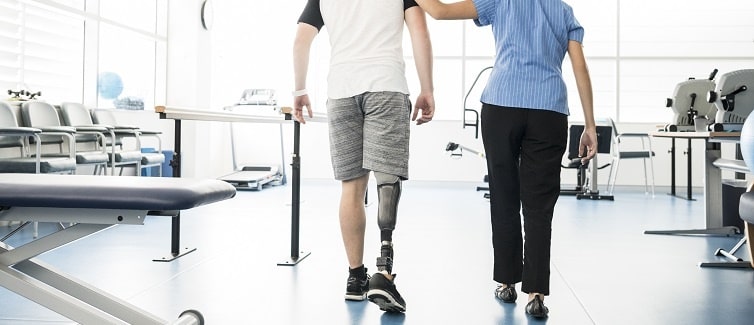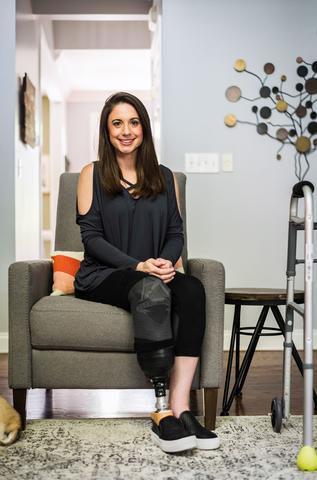Amputation, whether it’s a limb or a toe, can be a difficult and traumatic experience. And everyone copes differently.
It’s normal for you to feel a range of emotions from relief (if you were suffering from constant pain before the amputation) to grief, anger, and even depression.
You also will need to adjust physically. You’ll need to relearn how to do many everyday tasks. If you have a prosthetic limb, you will need to learn how to use it and care for it.
Rehabilitation focuses on helping both mentally and physically.
Coping After Amputation: Adjusting to a New Life
Having a limb amputated means being dependent on others for help, at least for a time.
As you recover and go through rehabilitation, you will steadily regain more independence and learn how to do basic daily activities in a new way. Although it may be difficult to ask for help, you’ll need it at first. It’s important to learn to accept help when offered.
“The rehabilitation part is so critical early because people haven’t thought about walking since they were toddlers,” says Michael Munin, MD, professor in the Department of Physical Medicine and Rehabilitation at the University of Pittsburgh School of Medicine. “Often as adults they’re now having to re-learn how to walk from start.”
Needing help can make you feel like you’ve lost some control of your life. Recognize what you can do for yourself and let others know when you do and do not need help.
Emotional struggles are normal. Realize that you don’t have to deal with them alone. Talk with family and friends, a counselor, or support group about your feelings. Finding others who have gone through a similar experience may help you realize what’s possible. Spiritual support may also help you, whether from church leaders or members, or just taking your own time to reflect.
“There is an emotional side of losing a body part, and we try to emphasize the positive of restoring physical functioning,” Dr. Munin says.
Life After Amputation: Recovering Physically
Rehabilitation starts while you’re still in the hospital and can last weeks or even months after the amputation surgery.
Depending on your needs, a rehabilitation program will help you re-learn how to dress, walk, and eat, as well as balance and coordination, how to care for your skin around the amputation, and how to adjust to a prosthesis.
Rehabilitation can include occupational and physical therapy. Prosthetists also hold an important role during the rehab admission process. They fabricate the prosthetic limb and make adjustments as needed to maintain patient comfort with the device.
Dr. Munin says learning to trust a new limb is an important part of the early rehabilitation process. For example, someone might not feel comfortable putting full weight on a prosthetic leg.
“We try to master that skill first, and then we focus on technique,” he says.
- Physical therapists will help you take care of your skin, manage swelling, and deal with phantom pain. In physical therapy, you will also learn how to care for your prosthesis and how to put it on and take it off. You’ll also learn stretching and strengthening exercises, as well as gait training to help you stand even and regain balance. Therapists also will work on your cardiovascular endurance.
- Occupational therapy will help you regain independence by helping you master activities of daily living. These include basic household chores, bathing, getting dressed, and toilet and tub transfers. Your occupational therapist will also recommend and show you how to use any assistive equipment that will make life at home easier. The therapist will also provide you any environmental modifications you need at home, at work, or for driving.
The occupational and physical therapy tie in together to help a patient recover.
“Ideally, the goal is that a patient would ultimately, when they finish all of their training, that they’ll put the leg on in the morning, take it off in the evening, and have a full day of wear schedule,” Dr. Munin says. “All of these facets have to be addressed to achieve the high outcomes that we hopefully obtain for our patients.”
Going out for the first time after an amputation can be intimidating. It helps to practice things you’ll encounter before going out so you feel more confident. Either at home or in a rehab program, you can practice navigating curbs, stairs, ramps, and uneven ground.
As you continue working, you will begin to regain some normalcy and feel more confident about your abilities. In time, it helps to focus on what you can do, rather than what you’re unable to do.
“We try to put the potential goals in their view so they realize they have a lot to shoot for and aim for in terms of restoration and function,” Dr. Munin says. “We can’t get everything back, but we can really restore a lot of function if the prosthetic rehabilitation is done in a concentrated, coordinated fashion.”
Mental Health After Amputation
Dr. Munin says doctors, nurses, and staff also monitor a patient’s mental health after an amputation. They treat it on a case-to-case basis, evaluating factors like a patient’s mental history, support system, and more.
Sometimes new problems can happen: depression, suicidal thoughts, body image issues, and post-traumatic stress. In serious cases, doctors can seek a psychiatric consult.
“It is certainly something we monitor closely for,” Dr. Munin says.
If you feel signs of depression, such as lack of motivation, loss of interest in things you once cared about, and ongoing grief or sadness, talk to your therapist or a counselor. The earlier you get help, the sooner you’ll feel better and can continue recovering.
Source: https://share.upmc.com/2020/03/coping-with-amputation-50ph/


